The "Conversion" of the Tribesmen
Christianizing of the Heathen – on the point of a sword!
“That force was often used in the conversion of northern peoples is undeniable, and it was used with a ferocity and violence beyond anything the conquistadors did in the Americas and far beyond anything that happened in modern Africa or Asia.”
– Andrew Walls, The Missionary Movement in Christian History, p72
Part of Christian mythology relates to the “winning for Christ” of the fierce Germanic tribesmen who purportedly destroyed ancient civilization. In very broad brush terms, we are given a comforting image of the heroic priest, armed only with his Bible and Christian forbearance, who subdues the savage warriors with homilies from the Good Book. (We are, of course, being offered an early-day version of how European colonial “missionaries” saw their own activity).
As if by magic (or rather, miracle, such is the efficacy of the Lord’s word) whole tribal confederations and vast tracks of Europe are baptised to Christ. Where the legions of Caesar had failed to vanquish, a humble monk with bell, book and candle triumphs. In a trice, Europe becomes a patchwork of “Christian kingdoms” and history becomes a story of the consolidation of regal power, the mopping up of a few recalcitrant pagans and suppression of the odd heresy.
As ever in the history of Christianity, the truth is far darker and far bloodier.
Hearts & Minds
Why did barbarian chieftains convert?
Barbarian ‘aristocracy’ was the highest echelon of an ‘heroic’ social structure. Raids into neighbouring territories were an essential part of the barbarian economy. By acquiring ‘prestige goods’ – such as slaves, jewelry, gold pieces, fine weapons – the barbarian ruling elite preserved its rule and raised its social status. Success at raiding strengthened the link between a chief and his warriors.
Yet tribal leadership itself was always threatened by the great social mobility of tribal society. At any time, any bold and able warrior could raise his own status and become a new member of the elite or even a chieftain. High Kings (or Great Khans) were effectively the result of an election held by clan or tribal elders in time of emergency. The claims of a barbarian ‘king’ to legitimacy were fragile and leaderships changed often and violently.
This ‘aristocratic vulnerability’ became especially acute during the period of migrations in the 3rd to 5th centuries, when tribal territories were ill-defined and ever-changing, tribal alliances continuously made and remade, and warriors of the same tribe fought both for and against the Romans.
In a word, barbarian leadership was neither well-defined nor secure.
Contact with Rome meant influence from a world which was everything barbarian society was not: a stable ‘kingdom’ that seemingly embraced the whole world and existed ‘forever’. Roman society by the 5th century was becoming ever more rigid and hierarchical, with eroding social and geographic mobility and an immense and widening gulf between rich and poor. Rome’s urban middle class was being taxed out of existence, freedmen were being confined in indentured labour and hereditary employments and the soldiery was being reduced to a peasant-farmer militia.
By emulation, these characteristics helped to accentuate the growth and the power of a more rigid and stable barbarian aristocracy.
In short, tribal chieftains wanted to rule like Romans:
“Every Goth wishes to be like a Roman, ” said Theodoric, “but only the humblest Roman wants to be like a Goth.”
So strong was barbarian desire to establish a ‘Roman’ legitimacy for their new kingdoms that the illiterate Charlemagne, centuries later, styled himself “King of Franks and Lombards and Patrician of the Romans.” He was crowned Emperor and Augustus.
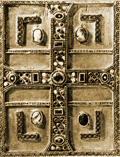
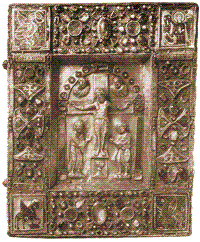
Christ Magic – Not for Reading!
Gem encrusted Bibles – just the thing for an illiterate king.
Christian literature: precious gems on the cover – nonsense within.
The few remaining books had become “sacred objects”.
Such objects filled the illiterate tribesmen with awe. Special shrines (“cumdachs”) were built to house these dazzling artifacts, regarded as having talismanic properties.
“Bede related how scrapings from Irish manuscripts were used to treat snakebites, while popular superstition suggested that the Book of Durrow had the ability to cure sick cattle.”
– I. Zaczek (Celtic Art and Design, p10)
Christian Heroes: Visigoths!
Made infamous by their victory over Valens at Adrianople in 378, and for the sack of Rome in 410, the Visigoths frequently fought in defence of Roman civilization.
A 1000 years before Luther’s German bible the monk Ulphilas (311-388) gave the Goths a written script and thereby a vernacular version of the Bible – though none could read! For all the fame given to Ulphilas, it was actually Roman captives who first introduced Christianity into the Gothic lands. Later in the century, in a tribal civil war, one particular clan adopted the Christian god. In the conflict between chieftains of the Thervingi tribe, Fritigern was induced by his Roman allies to adopt Christianity (or at least deploy ‘Christ magic’) against the ‘old gods’ of Athanaric. When the pagan Athanaric died in 382 even he was honoured with a Christian state funeral in Constantinople, and his ‘royal house’ continued – as ‘Arian’ Christians!
The first tribal confederation to be settled within the empire, the Visigoths actually left Italy as allies (foedus) of the Roman emperor in pursuit of earlier invaders – Siling Vandals, Suevi and Alans – tribes they confronted and annihilated in Spain. Their reward (418) was territory in southwest Gaul (Aquitaine). This they later extended to include most of Spain. The Visigoths also provided most of the cavalry in the motley force that stopped Attila and the Huns in 451.
When Aquitaine was lost to the Franks, the Visigothic kingdom in Spain continued, though considerably weakened by Christian sectarianism. The original Arian faith was never forced on the indigenous people but when, in 587, King Recared converted to Catholicism – a weapon in another Visigothic civil war – religious intolerance arrived.
At the 3rd Council of Toledo (589) Spain became a theocratic state: Arianism was proscribed, Jews were enslaved, and pagans murdered.
The Visigoths in Spain were themselves destroyed by Arabs in the 8th century. They disappeared from history in little more than 300 years.
Follow My Leader ... into the baptismal font
Once a warrior king embraced ‘Christianity’ – an adoption of form and formality with little or no regard to content – the warrior aristocracy followed its king. Thus, for example, when Clovis accepted Christ as his new god, he compelled three thousand of his retainers to follow him into the baptismal font.
Among the common tribesmen religious allegiance was not an issue of conscience. This was not an age of individual opinion or preference. When the tribal leadership adopted a new god the tribe followed suit. Not to have done so would have been tantamount to rebellion. When Charlemagne insisted on baptism as the sign of submission, he punished with appalling barbarity any resistance, as when, in cold blood, he beheaded, in a single day, 4500 Saxons at Verden, in 782 AD.
Having adopted Christ as their new god, the warrior aristocracies forced the new faith on their peoples.
Christian Heroes: Ostrogoths!
“The professors of grammar, rhetoric and jurisprudence were maintained in their privileges and pensions by the liberality of the Goths.”
– Gibbon (Decline & Fall, ch 39)
The eastern branch of the Goths had adopted a more nomadic existence than their Visigothic cousins, in the grasslands of the Ukraine of the 2nd century.
Unfortunately the Ostrogoths were the first European tribe to be subjugated by the Huns and formed part of Attila’s confederacy. With Attila’s death, the Ostrogoths reasserted themselves under their own kings. Eastern Emperor Zeno first hired them to guard the northern frontier and gave them land in the Balkans. Nervous of their presence so close to Constantinople, he persuaded the Goths under their astute king Theodoric to retake Italy from Odoacer.
As ‘Consul of the Romans’ as well as chieftain of the Goths, Theodoric (493-526) ruled the Gothic world from a palace at Ravenna, modelled on Diocletian’s palace at Spalato. Throughout his realm much of Roman civilization was actually restored. Theodoric’s administrators were Roman; he maintained the senate; he made Roman patricians, like Boethius, consuls. He also checked the expansion of the Franks and brought peace to the west. T He was also a Christian of the Arian persuasion.
Theodoric’s many dynastic links included a marriage to Audofleda, the sister of Clovis, king of Franks. He ruled Spain on behalf of his infant grandson; pacified the Vandals and protected the coasts with a fleet of a thousand vessels. In Rome he presided over games in traditional Roman manner; the dole was still distributed and the aqueducts still flowed.
After his death in 526, his daughter Amalasuntha ruled the Ostrogothic kingdom as regent. His grand daughter Matasuntha married Germanus, nephew of the Eastern Roman Emperor. But by then Romano-Gothic Italy had been destroyed by Catholic armies from the east.
Invasion by Justinian and 30 years of warfare (Rome changed hands four times) destroyed urban civilization in Italy and brought whole regions to famine.
“Byzantine rule lasted just 14 years before an invasion of Lombards under Alboin swept it away.
Instead of a powerful and virile Gothic state that might have fought off the barbarians, Italy had no resistance to offer. Rome became a backwater, and the victories of Justinian a disaster for the Christians of the West.”
– Geoffrey Regan, Decisive Battles, p40.
The Lost World of "Gothica" (c. 450-550)
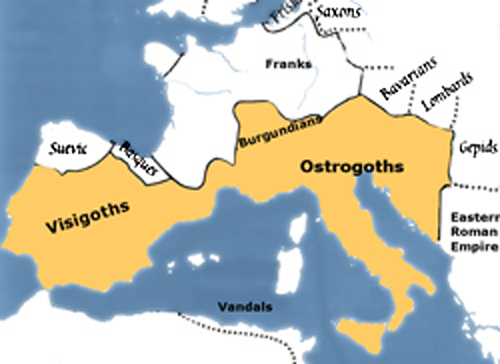

Theodoric's Mausoleum, Ravenna.
Built in 526 by his daughter Amalasuntha.
Worthy of the age of Augustus or Hadrian, the thirty feet wide central 'chapel' is crowned by a single piece of granite weighing 450 tons.
Under the Goths, Roman intellect had not yet disappeared.
Enter the Christian Bishop...
Rome – as represented by the local aristocrat-cum-bishop – could bestow legitimacy, and with it all the pomp and ceremonial that filled subject people with awe and obedience. As the empire decayed, its rituals and regalia became ever more ornate and overbearing.
The barbarian kings delighted in Roman titles –which they put on their coinage, modelled very closely on Roman coinage. From 382 onwards barbarian tribes had been granted the status of ‘federate of the Romans’ (foedus) and their chieftains had been accorded patrician status. Some barbarian chiefs (for example, Fravitta, in 401) were even raised to the status of consul. When there were no longer emperors to bestow some grand honorific, the occasion fell into the hands of the bishop.
The barbarian kings sought marriage into the imperial bloodlines.
In a notable example, the Empress Galla Placidia was carried off to Gaul by the Goths, and in 414 she was married (in a Roman-style wedding ceremony) to the Visigothic chieftain Athaulf at Narbonne. The bridegroom wore a toga! ‘Catholic princesses’ were conveniently found at many convenient moments: Ingund married to Hermengild in 583 (intensifying the Gothic civil war in Spain); Bertha married to the Saxon Aethelbert in 600 (levering the Catholic church into Kent); and of course Clotilda, married to the hero Clovis.
Theodoric’s many dynastic links included a marriage to Audofleda, the sister of Clovis, king of Franks. He ruled Spain on behalf of his infant grandson; pacified the Vandals and protected the coasts with a fleet of a thousand vessels. In Rome he presided over games in traditional Roman manner; the dole was still distributed and the aqueducts still flowed.
The barbarian kings wanted Roman patricians in their entourage, men who could advise them in the governance of their newly acquired peoples. Everywhere, the indigenous ‘Romans’ outnumbered their warrior overlords.
The outstanding example is the court of Theodoric, Ostrogothic king of Italy. His administration was modelled on that of his imperial predecessors and was staffed by Romans. Among ‘men of letters’ at his court was Aurelius Cassiodorus, senator, statesman, monk and writer. As the local “statesman” the Bishops “spoke” for the native people and offered “administration” of cities and districts on behalf of the alien king.
Thus arose the Dark Age elite – a fusion of ex-pagan chiefs, who were in awe of all things Roman (including its Christianity), and degenerate Roman landowners who survived by foisting Christianity on to superstitious tribesmen.
Civil and ecclesiastical power coalesced. Saying much the same thing in Christ-speak, Bishop Isodore of Seville (560-636):
“Those who will not practice virtue by the admonition of the priest, may be kept from doing evil by the power of the king.”
– Isidore, Sententiae, I, 16.
The very heart of this veneer of legitimising romanitas was the religion by which the emperors had legitimised and made ‘divine’ their own rule – Christianity. Hence the rise and rise of the Christian bishops and, in particular, the Bishop of Rome – the custodian of the corpse of the empire and self-styled bestower of its legacy.
We Come in Peace
With his book of Christian spells and the inheritance of more than a thousand years of Roman ‘gravitas’ behind him, the patrician-bishop easily swayed the untutored mind of a barbarian king.
As well as “Christ magic” he offered “legitimacy” and the power of the written word for kingly diplomacy. With his help, an upstart king’s authority could now be proclaimed everywhere.
With bribes and baubles, he gained access; he took on the role of ambassador and agent; he lent support to one side against another in fratricidal conflict; he advised; he provided ‘virgin brides’ and officiated at royal weddings and ceremonials; he governed the locals on behalf of his barbarian overlord.
Through it all, his own wealth and authority grew. And the nonsense he peddled – Christianity – became official dogma.

How the West was Won: The Rise and Rise of the Franks
Before the closing years of the 5th century the Christian Church showed no interest in converting barbarians. God, it seems, had chosen the Roman Empire to spread his Word. Yet when the fierce tribesmen arrived at the city gates, that event was “God’s Judgement” and the Christian bishops were all too ready to abandon the empire and throw in their lot with the invader.
Despite the ‘3-day wonder’ of the sack of Rome in 410 by the Visigoths, it was Gaul that was in dire straits in the 5th century, not Italy (which enjoyed a late ‘Indian summer’ under its Gothic king.)
In the late 5th century Salian Franks under Clovis began three centuries of expansion by absorbing the other Frankish tribes. In 486 Clovis defeated the Roman general Syagrius and the last Gallo-Roman region of Gaul – Soissons – was overrun. Subjugation of the Thuringians and Bavarians, followed.
The Franks were a heathen German tribe, almost the only one untouched by Arianism, spreading from the east. While the primitive Franks continued to give homage to their old Germanic gods, other, more Romanised, tribes had adopted Arian Christianity as a ‘national’ religion.
Backward and barbarous they may have been but for the beleaguered Catholic bishops, the Franks were the great hope. In the Franks, the papal agents found a fierce but malleable tribe and they spared nothing to bring the Frankish overlords under their sway. The dominion of the Franks in the west ensured the triumph of Roman Catholicism.
Thus, the “conversion” of Clovis is a crucial event, comparable to the “conversion” of Constantine – and equally is surrounded by the same fanciful mythology.
Clovis’s conversion, like Constantine’s, was no “inward experience of grace” but was a military matter. He was convinced that victory in battle lay in the gift of the god of the Christians. Christ for him was a talismanic war god.
According to the myth, in 496, after a close call against the Alamanni, the day had been ‘saved’ by a prayer either from Clovis himself, or the Catholic Bishop Gregory of Tours (or maybe both!) A grateful Clovis took baptism, to become the first “Catholic” ruler in the west.
Of course, he had been softened up somewhat by marriage in 493 to a Catholic princess, the Burgundian Clotilda, put forward as his bride ‘on account of her beauty and wisdom’ (and no doubt her Catholicism!) Clovis, like Constantine a century and a half earlier, was also aware of the political advantage of posing as a liberator of “those oppressed by religious heresy”:
“It grieves me to see that the Arians possess the fairest portion of Gaul. Let us march against them, vanquish the heretics, and share out their fertile lands.”
In 507 Clovis took Aquitaine from the weak Visigothic king Alaric II, and then subjugated Burgundy. Both areas were forcibly converted to Catholicism – to the delight of the local bishops. The Franks became the major force in the west, weakened only by the traditional division of the kingdom between the king’s sons (hence, Neustria, Austrasia, Burgundy, Bavaria).
Franks and Catholics – Warriors for the Faith
At Clovis’ death in 511, Clotilda went into a monastery at Tours where she stayed until her death in 545. No surprises that she made the sainthood!
In the half century after Clovis, the belligerent Franks advanced eastward as far as the Elbe and took advantage of the preoccupation of the Ostrogoths with Justinian’s invasion of Italy to seize Gothic territories in Gaul and the north.
Clovis’s kingdom was split between Chlodomer (Orleans), Childebert (Paris), Chlotar (Soissons), and Theuderic (Metz). The upstart Pepin III ended this “federalism” in the 8th century. The pope, Stephen II, legitimized his regime in 754 by anointing Pepin ‘King of the Franks.’ Papal fear of Lombard expansion in the 8th century rendered the Vicar of Christ a dependent, first of the Frankish emperor and then of the German.
In return for the papal endorsement, in 756, Pepin defeated the Lombards and conquered Ravenna (taken 5 years earlier by the Lombards from the Byzantines). Pepin left the conquered territories to the Pope, thereby founding the ‘Papal State’ and establishing a temporal power for the Vicar of Christ, who was at last free of fetters from the emperor in the east.
The “special relationship” of the Franks and the Papacy would endure for centuries. In time, the relationship would be reverse: Popes would make and break kings and emperors.
The religious war – such a fine innovation of Christianity! – would never end. In the 8th century, Frankish conquest carried the sword of Christ to the throat of the Thuringians and Bavarians, and halted the armies of Islam that had overwhelmed the Visigoths in Spain.
Towards the end of the century, after forty bloody years of continuous aggression, Pepin’s son Charlemagne had extended his personal rule over part of Spain, most of Italy and all the German lands. Charlemagne’s Franks slaughtered tens of thousands of Saxons, Avars and Slavs in order that they might know God’s loving kindness – just what the Galilean carpenter had in mind?

Butcher for Christ – Charlemagne
“King of Franks and Lombards and Patrician of the Romans.”
The most joyful moment for the papacy came when Pope Leo III, recently half-blinded by an angry mob, outwitted Charlemagne, kneeling at prayer. By producing a hidden crown and placing it on the emperor’s head – to a simultaneous chorus of acclamation– the peeved Charlemagne reluctantly accepted that he had been ‘crowned by the Pope,’ a precedent that would be used by the papacy for a thousand years.
Sources:
- Chris Scarre, Chronicle of the Roman Emperors (Thames & Hudson, 1995)
- Robert Graves, Count Belisarius (London, 1938)
- Arthur Ferrill, The Fall of the Roman Empire (Thames & Hudson, 1986)
- Helen Ellerbe, The Dark Side of Christian History (Morningstar & Lark, 1995)
- Richard Fletcher, The Conversion of Europe (Harper Collins, 1997)
- Edward Gibbon, The Decline & Fall of the Roman Empire (1799)
- Michael Grant, The Climax of Rome (Weidenfeld& Nicolson, 1996)
- Michael Grant, Fall of the Roman Empire (Weidenfeld& Nicolson, 1996)
- Robert Wilken, The Christians As the Romans Saw Them (Yale UP, 1984)
- Robin Fox Lane, Pagans & Christians (Viking, 1986)
Related Articles:
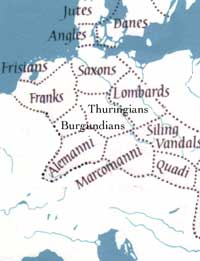
Rome's Northern Neighbours
Tribal distribution – late 4th century
Ornate Silver cover – 6th century copy of the Gothic Bible
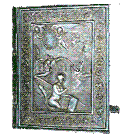

Rome's Northeastern Neighbours
Tribal distribution, northeast of the Danube – late 4th century
Vandals
Desperate and on the verge of starvation, the Vandals crossed the frozen Rhine in the winter of 406. They remained in Gaul only 3 years, migrating instead to more sparsely populated Spain.
Under the leader Gaiseric (who remained their king for 50 years) the Vandals became a major naval power, controlling the western seas and harassing the eastern.
Forced out of Spain by the Visigoths, the Vandals stormed and occupied the Roman provinces of North Africa, where they established a highly Romanised and Arian kingdom, notable for its Latin poets.
Infamous for their 14-day sack of Rome in 455, the Vandals – along with Roman civilization in North Africa – were devastated by the Catholic armies of Justinian/Belisarius in 534.
North Africa never recovered.
A Romano-Vandal knight waves good-bye to his walled villa


Justinian (another Christian "Great") – bankrupted the East by destroying the West!
Church of the Holy Wisdom – (Istanbul)
Eastern Emperor Justinian starved and robbed his troops and was merciless in his rapacious taxation – but he did build a big church.
Millions died as a result of his greed and vanity. Edward Gibbon estimated that the number of lives lost during the half century of his reign might have approached a hundred million.
Procopius, in The Secret History, put the number even higher. But then, we do have that big church …
Top Dog!
Kingships bestowed by the Bishop
(13th century, Mainz)


The Missionary Position
Catholic missionaries were effectively Frankish agents, moving out in conjunction with the conquering armies.
629: Amand, a bishop from northwest Gaul, overcame fierce local resistance to establish monasteries in ancient Belgium,
647: Amadeus, Bishop of Maastricht, moved into the lands of the Frisians. Later he moved further east, among the Slavs.
690: Northumbrian monk Willibrord followed him into Frisia and is designated by Pope Sergius ‘Bishop of Utrecht.’
719: The Pope sent West Saxon monk Wynfrid to the heathens of Saxony. He is given the code name “Boniface.”
724 St. Boniface fells the Great Oak of Geismar, Hesse, sacred to Thor.
Despite the ruthless eradication of overt paganism the pagan fertility goddess Ostara (Eostara) gave her name to ‘Easter’.
Resistance is Futile?
Etymological clues exist of a forlorn pagan resistance to ‘conversion’ –
BIGOT, meaning an obstinate and intolerant holder of particular religious opinions, arrived in English via French. It originated centuries before among Germanic/Frankish tribes of Gaul. ‘Bei Gott’ (‘By God’) mocked the exclamation frequently used by the crusading Christian missionaries who were bludgeoning the tribes into conversion.
CRETIN, a stunted or intellectually subnormal person, came into English in the 18th century from Franco-Provençal ‘creitin’ or ‘crestin’, again both ancient in origin, derived from the Old French ‘chretien’ and the Lombard, ‘cristanei’ – meaning “Christian”!
